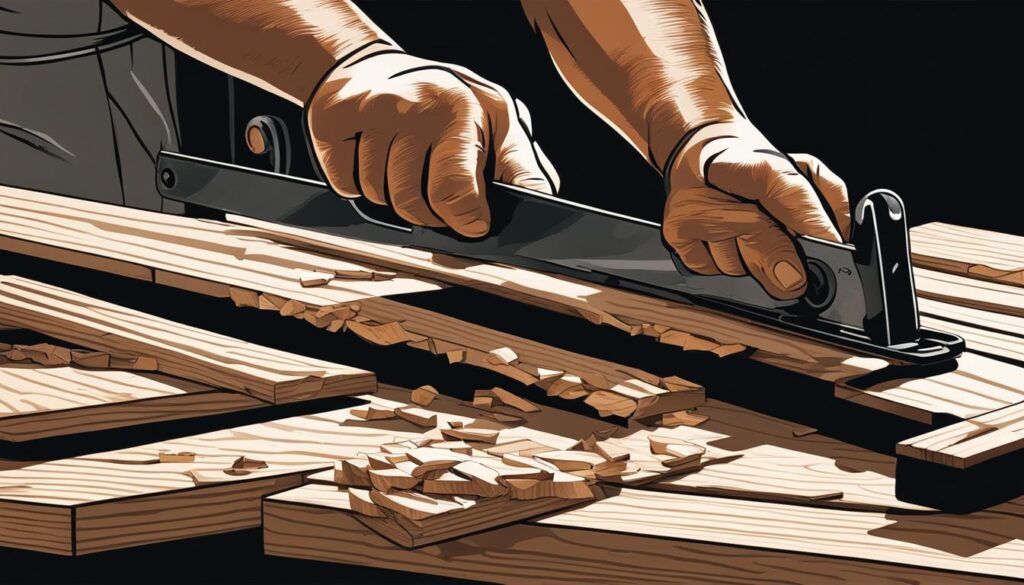We may earn money or products from the companies mentioned in this post.
If you’re venturing into woodworking business, it’s essential to have a clear plan in place. As a woodworking business owner, there are several strategies you can use to achieve long-term success.
In this section, we’ll go through the top woodworking business strategies that can help you unlock success in the US woodworking industry. These strategies are designed to help you stay ahead of competitors while maximizing your profits.
Key Takeaways
- Develop a clear plan for your woodworking business
- Stay up to date with industry trends and emerging markets
- Create an effective business plan that includes all key elements
- Implement marketing strategies specifically tailored for woodworking businesses
- Maximize your woodworking product development to stand out in a competitive market
Understanding Woodworking Industry Trends
Staying up-to-date with current woodworking industry trends is crucial for any business looking to succeed. By keeping abreast of the latest market shifts, consumer preferences, and technological advancements, you can better position your woodworking business for growth and success.
Current Market Trends
One of the most significant industry trends is a growing interest in sustainable and environmentally friendly woodworking practices. Consumers are increasingly conscious of the environmental impact of their purchases and are seeking out products made from responsibly sourced materials.
Another trend is the rise of the maker movement, which has led to a renewed interest in handcrafted woodworking products. Additionally, there is a growing demand for functional and multipurpose products that can adapt to smaller living spaces.
Emerging Markets
New markets are emerging all the time, and woodworking businesses should keep an eye on these to stay ahead of the competition. One such market is the growing interest in artisanal and custom-made wooden furniture, which is particularly popular among younger consumers. Another emerging market is the need for high-quality wooden products in the hospitality industry, such as hotel furniture and restaurant interiors.
Technological Advancements
Advancements in technology are transforming the woodworking industry. For example, computer-aided design (CAD) software has revolutionized the furniture design process, while robotics and automated machinery have increased efficiency and precision in woodworking production.
Other technological advancements that are changing the industry include the use of 3D printing for prototyping and the availability of online marketplaces for selling woodworking products.
Developing Effective Woodworking Business Plans
Having a well-structured woodworking business plan is critical to achieving success in the industry. Your business plan serves as a roadmap, a tool to help you stay focused and achieve your goals. A robust business plan should include:
- Market analysis: Conducting thorough market research, identifying your target audience, and assessing your competition are crucial elements of any successful woodworking business plan.
- Product or service description: Clearly defining the products or services you intend to offer, their unique selling points, and how they meet your customers’ needs.
- Marketing strategy: Developing a marketing plan that outlines how you will promote your products or services to your target audience.
- Operational plan: Establishing your business’s organizational structure, identifying staffing needs, and outlining your daily operational procedures.
- Financial plan: Defining your financial objectives, creating a budget, and preparing financial projections based on your estimated revenue and expenses.
Market Analysis: Identifying Your Target Audience
Conducting comprehensive market research is essential to understanding the woodworking industry’s current trends, emerging markets, and the behaviors and needs of your target audience. Identifying your target audience involves defining your ideal customers’ demographics, understanding their purchasing habits and decision-making processes.
You can collect data from various sources, including industry reports, surveys, online forums, and social media platforms. By analyzing this data, you can develop valuable insights that will inform your product development, marketing strategy, and customer service approach.
Developing Your Product or Service Description
Your products or services are the foundation of your woodworking business. When developing your product or service description, it’s important to highlight the features and benefits that set them apart from your competitors. This includes details such as the materials used, design specifications, production process, and pricing strategy.
Additionally, you should consider any challenges or limitations you may face in production, such as sourcing materials or manufacturing lead times, and address these in your business plan.
Creating Your Marketing Strategy
Your marketing strategy should outline how you will attract and retain customers. There are several marketing tactics you can use, including:
- Social media marketing: Developing a strong presence on social media platforms and engaging with your target audience through regular posts and interactions.
- Search engine marketing: Optimizing your website with relevant keywords to improve its search engine rankings.
- Email marketing: Creating email campaigns to keep your subscribers updated on new products or promotions.
- Events and promotions: Hosting events or offering promotions to entice customers and generate interest in your products or services.
Defining Your Operational Plan
Your operational plan should detail your day-to-day business operations, including staffing needs, inventory management, and production schedules. You should also address any potential obstacles or risks that may arise and how you plan to mitigate them.
It’s important to establish a clear organizational structure and job roles to ensure everyone knows their responsibilities and expectations. Additionally, having a comprehensive employee training program can help improve your overall operational efficiency.
Preparing Your Financial Plan
A financial plan is necessary to ensure your woodworking business remains profitable. This includes setting financial objectives, creating a budget, and projecting your anticipated revenue and expenses. It’s crucial to track your finances regularly to identify any issues and make adjustments as needed.
Including all of these key components in your woodworking business plan can help you establish a successful and sustainable business in the industry.
Implementing Marketing Strategies for Woodworking Businesses
Marketing your woodworking business effectively is the key to success in the competitive U.S. woodworking industry. By implementing the right strategies, you can attract more customers, increase sales, and grow your business. In this section, we will explore effective marketing techniques tailored specifically for woodworking businesses.
Identifying Your Target Audience
The first step in developing a successful marketing strategy is identifying your target audience. Understanding your customers’ demographics, preferences, and interests can help you tailor your marketing efforts and reach them more effectively. Consider conducting market research or surveys to gain valuable insights. Use this information to create buyer personas, which can help you craft messaging and content that resonates with your customers.
Building a Strong Online Presence
In today’s digital age, having a strong online presence is crucial for any business. Create a professional website that showcases your products and services. Use search engine optimization (SEO) techniques to ensure that your website ranks high in search engine results. Use social media platforms such as Facebook, Instagram, and Twitter to connect with customers and promote your business. Utilize email marketing campaigns to stay in touch with your customers and keep them informed about new products, special offers, and upcoming events.
Networking and Building Relationships
Networking is a valuable marketing strategy that can help you establish relationships with potential customers and other businesses in your industry. Attend industry events and conferences, join trade organizations, and participate in online forums and groups. Building relationships with other woodworkers and industry experts can help you find new customers, learn about emerging trends, and gain valuable insights.
Offering Special Promotions and Discounts
Offering special promotions and discounts is another effective marketing strategy for woodworking businesses. Consider offering limited-time discounts, free shipping, or buy-one-get-one-free deals. These promotions can help attract new customers and generate repeat business. Use email marketing and social media to promote your special offers and create a sense of urgency.
Showcasing Your Expertise
As a woodworking business owner, you have valuable expertise that can set you apart from your competitors. Consider creating educational content such as blog posts, how-to videos, and tutorials that showcase your knowledge and skills. This content can help you establish yourself as an industry expert and attract customers who are looking for high-quality products and services.
Implementing these marketing strategies can help you attract and retain customers, increase sales, and grow your woodworking business in the U.S. woodworking industry.
Maximizing Woodworking Product Development
Developing innovative and high-quality woodworking products is essential for standing out in a competitive market. Maximizing woodworking product development requires a comprehensive approach that encompasses research, design, prototyping, testing, and refining. Here are some strategies to help you excel in woodworking product development:
Conduct In-Depth Product Research
Before diving into woodworking product development, it’s essential to conduct extensive market research. This research can help you understand market gaps, identify potential niches, and evaluate consumer needs and preferences. By gathering relevant data, you can create products that target specific market segments and meet consumer demands.
Focus on Design
Design is a crucial element of woodworking product development. A well-thought-out design can differentiate your products and make them more appealing to consumers. This stage requires creativity, attention to detail, and a deep understanding of the target audience. Consider factors such as color, shape, size, and functionality when designing your woodworking products.
Prototype and Test Products
Prototyping and testing are fundamental to woodworking product development. By creating a prototype, you can identify design flaws, evaluate materials, and test product functionality. This stage also helps you identify potential manufacturing challenges and refine your design. Testing your woodworking products is also vital as it ensures that your products meet quality standards and customer expectations.
Refine Your Products
After testing your woodworking products, it’s essential to refine them based on feedback and suggestions. Refining can involve tweaking the design, incorporating new materials, or enhancing the product’s functionality. By continually improving your products, you can create a loyal customer base and stand out in a competitive market.
| Product Development Strategies | Benefits |
|---|---|
| Incorporate customer feedback in product design | Increases customer satisfaction and loyalty |
| Use high-quality materials in product development | Enhances product durability and quality |
| Offer customization options for products | Increases customer engagement and satisfaction |
| Partner with suppliers to source unique materials for products | Offers product differentiation and innovation |
By maximizing woodworking product development, you can create high-quality, innovative products that meet consumer demands and stand out in a competitive market.
Managing and Growing Your Woodworking Business
Managing and growing your woodworking business requires careful planning, diligent execution, and a focus on continuous improvement. In this section, we will provide insights into key areas of woodworking business growth and management.
Inventory Management
Effective inventory management is essential for maximizing profits and minimizing waste in your woodworking business. By closely monitoring inventory levels and identifying which products are selling well, you can optimize your production processes, reduce costs, and avoid stockouts. Consider investing in inventory management software to help you keep track of your inventory and make data-driven decisions.
Financial Planning
Sound financial planning can help you make informed decisions about your woodworking business. By carefully analyzing your financial data, you can identify areas where you can reduce costs, increase revenue, and improve profitability. Consider working with a financial advisor to help you create a realistic budget and forecast future financial performance.
Employee Management
Building a strong team of skilled and committed employees is key to the success of your woodworking business. To effectively manage your employees, provide clear expectations, regular feedback, and opportunities for growth and development. Encourage open communication, collaboration, and a positive company culture that values teamwork and mutual respect.
Customer Service
Delivering exceptional customer service is critical to building and maintaining a loyal base of customers for your woodworking business. Make sure your employees are trained to provide knowledgeable and friendly service, and that you have systems in place to resolve any issues or complaints. Consider implementing a customer loyalty program to reward repeat customers and encourage referrals.
Scaling Your Business
Expanding your woodworking business to new markets or product lines can be a way to achieve sustained growth and profitability. To scale your business, consider conducting market research to identify new opportunities, developing a strategic plan for expansion, and investing in resources such as technology and human capital. Keep in mind that scaling your business requires careful planning and execution to ensure long-term success.
Conclusion
Success in the U.S. woodworking industry requires a combination of factors, including staying up to date with industry trends, developing effective business plans, implementing marketing strategies, maximizing product development, and managing your business efficiently.
Woodworking Business Success
By applying the expert tips and techniques discussed throughout this article, you can unlock success in your woodworking business. Success can take many forms, from achieving financial stability to expanding your market share or increasing customer satisfaction.
Whatever your goals may be, remember that success is a journey, not a destination. It requires continuous learning, adaptation, and improvement. Stay passionate about your craft, stay informed about market trends, and stay focused on delivering high-quality products and services to your customers.
By following the strategies outlined in this article, you can position your woodworking business for long-term success and growth in a competitive market.
FAQ
What are woodworking business strategies?
Woodworking business strategies are techniques and approaches used by woodworking businesses to achieve success. These strategies can include effective marketing, product development, business planning, and management techniques.
Why is understanding woodworking industry trends important?
Understanding woodworking industry trends is crucial for staying competitive and meeting customer demands. By staying informed about trends such as consumer preferences, emerging markets, and technological advancements, woodworking businesses can adapt their strategies to stay relevant.
How can I develop an effective woodworking business plan?
Developing an effective woodworking business plan involves conducting market analysis, identifying your target audience, projecting your finances, and creating marketing strategies. These elements will help guide your business and increase your chances of success.
What marketing strategies work well for woodworking businesses?
Marketing strategies such as online advertising, social media marketing, and networking can be effective for promoting woodworking businesses. These strategies help create brand awareness, reach a wider audience, and generate leads.
How can I maximize woodworking product development?
To maximize woodworking product development, it’s important to conduct thorough research, design innovative products, create prototypes, test them, and refine them based on customer feedback. This iterative process ensures that the final product meets and exceeds customer expectations.
What are some key aspects of managing and growing a woodworking business?
Key aspects of managing and growing a woodworking business include effective inventory management, financial planning, employee management, and providing excellent customer service. Additionally, scaling the business and expanding into new markets can lead to growth and increased profitability.
How can woodworking business strategies lead to success?
Implementing the right woodworking business strategies, such as staying informed about industry trends, developing effective business plans, implementing marketing strategies, maximizing product development, and managing the business efficiently, can lead to long-term success and growth in the woodworking industry.
Affiliate Disclosure: This post may contain affiliate links. If you purchase through our link, we may receive a small commission, but at no additional cost to you. For more information, please see our Disclosure statement.



